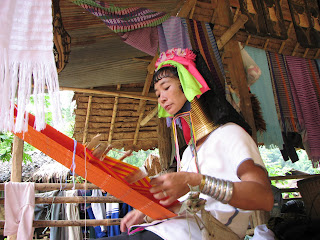We've spent much of the last couple of weeks in the rural north-east of Laos. We learned a lot there. We don't hear much about Laos where we come from, and we hear even less about unexploded ordinance (UXO).
Between 1964 and 1973, the American 'defence' forces dropped about 20 million tonnes of explosives on this little country - more than was dropped in Europe in the whole of WW2, or about one tonne per person living in Laos at the time. The operation was called the secret war, because that's what it was - while acknowledging there was a conflict in Vietnam at the time, the great western power declined to admit that it was bombing the hell out of Laos too. Worse than this, most of the bombs were dropped indiscriminately by pilots returning from missions over Vietnam, under orders to release all their bombs before returning to land. Like, just get rid of them, drop them anywhere.
It's thought that around 30% of that good ole American firepower failed to detonate when it hit the ground. So it's still detonating today, and has been for more than forty years.

Besides the great mass of large bombs droppen on Laos, enormous numbers of smaller ones were also dropped. Up to 90 million fist-sized bomblets -
bombi to locals - were released from larger casings, high above the ground, and spread out to cover large areas. Designed to kill and maim people (anyone, that is, not just soldiers, combatants, terrorists or whatever we call them nowadays), the
bombi are the kind of weapon that, after hitting the ground, and possibly burying themselves, lay in wait for the next person or beast that happens to disturb them. You know, the next farmer who tills his or her land, or plants rice, or the next kid who wants to run, play.
Why should such horrors be visited upon people? Well, the explanation is that back in the Sixties and Seventies there was a cold war on, and Laos was seen as a key part of the buffer between communists and the other mob. So it was about regime change. Though neither side was open about the secret war, both America and the North Vietnamese had large forces stationed in Laos. There was also a strategic imperative to close the line of supply - the Ho Chi Minh trail - along which supplies were brought to those fighting on the communist side of the Vietnam war. Another war that was about regime change.
Despite this nightmare delivered to them by the Americans - and there really is no shirking the blame - and the fact that there's never really been a satisfactory explanation given for these dirty actions, people smile, enjoy their lives and welcome visitors. The countryside is scarred, with large craters all around and marks left by the impact of rockets high on cliffs. You see signs warning of UXO, and plaques on the ground showing where it's safe to walk. People on crutches provide a reminder, and many have died over the last few decades.
Phew! Glad that's over. What a terrible period, what a base and ugly thing to do to a people. What a despicable result, that poor rural people should be denied access to land for agriculture, that kids should have to risk a maiming to play football. So glad we don't do that any more...
...or do we? Well, as a matter of fact, we do. These very same armaments, likely produced in the very same factories, are still being used today. Yep, 2007. A place called Afghanistan is one target, though we can't really be specific about where these things land. Still dropped by the same people, too, though this time the blame can be shared amongst all the allies (Coalition of the
what? The wicked?), including Australia. By implicating ourselves in such actions we condone the defilement of peoples' property and places. And while we're at it - supporting the use of such disgusting devices of terror - we also lend our support to those who produce and sell them.
In North-Eastern Laos, people go on with their lives, and are fiercely proud of their successful resistance and eventual defeat of what they call the "imperialists and their puppets". The fierceness of the attack they suffered seems to have steeled them. The area seems staunchly communist, though with some very obvious capitalist influence, and the people are proud and happy. In what seems a mixture of wry humour and basic practicality, there are fences made entirely of bomb casings, houses supported by them.

You'll be glad to know that there are clean-up programs in progress -
http://www.mag.org.uk/ will give you an insight.
On the subject of war and its methods, some questions come to my mind: Has anything much changed since the Seventies? Who are the terrorists? What constitutes a "weapon of mass destruction", and what doesn't? What are the targets and objectives in the "war on terror"? Is it OK to consider more my mortgage than my government's ethics when I go to vote? Why does my country demonstrate unquestioning alliance with a regime whose policy is to use land mines against farmers and children? What means are acceptable for achieving "regime change"? Indeed, when is it alright to tell a people how we'd like them to order their affairs?











 High in the mountains, and in a remote corner of the country, the city of Vieng Xai lies in a valley of massive limestone outcrops. In each of these outcrops are a network of huge caves. It was from here that the Pathet Lao - the Laos communist army - coordinated thier resistance.
High in the mountains, and in a remote corner of the country, the city of Vieng Xai lies in a valley of massive limestone outcrops. In each of these outcrops are a network of huge caves. It was from here that the Pathet Lao - the Laos communist army - coordinated thier resistance.




























































